SEO
What Are the Benefits of SEO? (And How to Get Started)
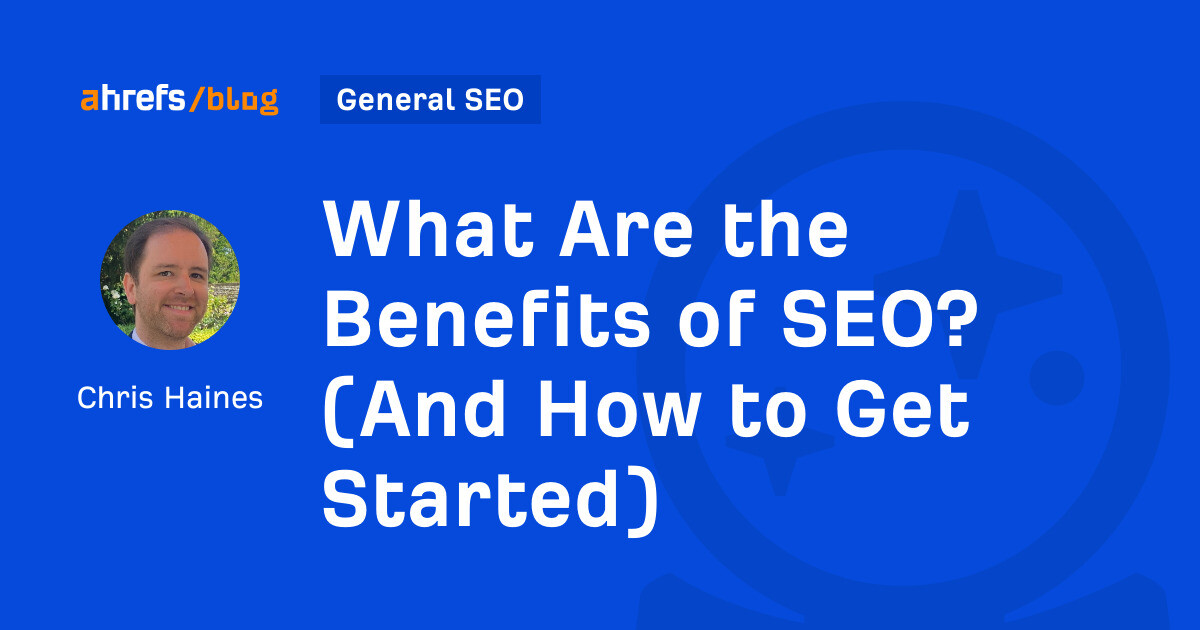
If you are a business owner, you may have heard about how vital search engine optimization (SEO) is. But how can it help fast-track your business’s growth, get more customers, and make a difference to your bottom line?
In more simple terms: Why do SEO?
There are an estimated 3.5 billion searches on Google each day. To tap into this audience, you’ll need to do SEO.
One of the key benefits of SEO is increasing your organic share of voice (SOV). More organic SOV means more traffic, leads, and revenue for your business.
It also means more market share in your industry. We can see from the graph below that there is a strong relationship between SOV and market share.
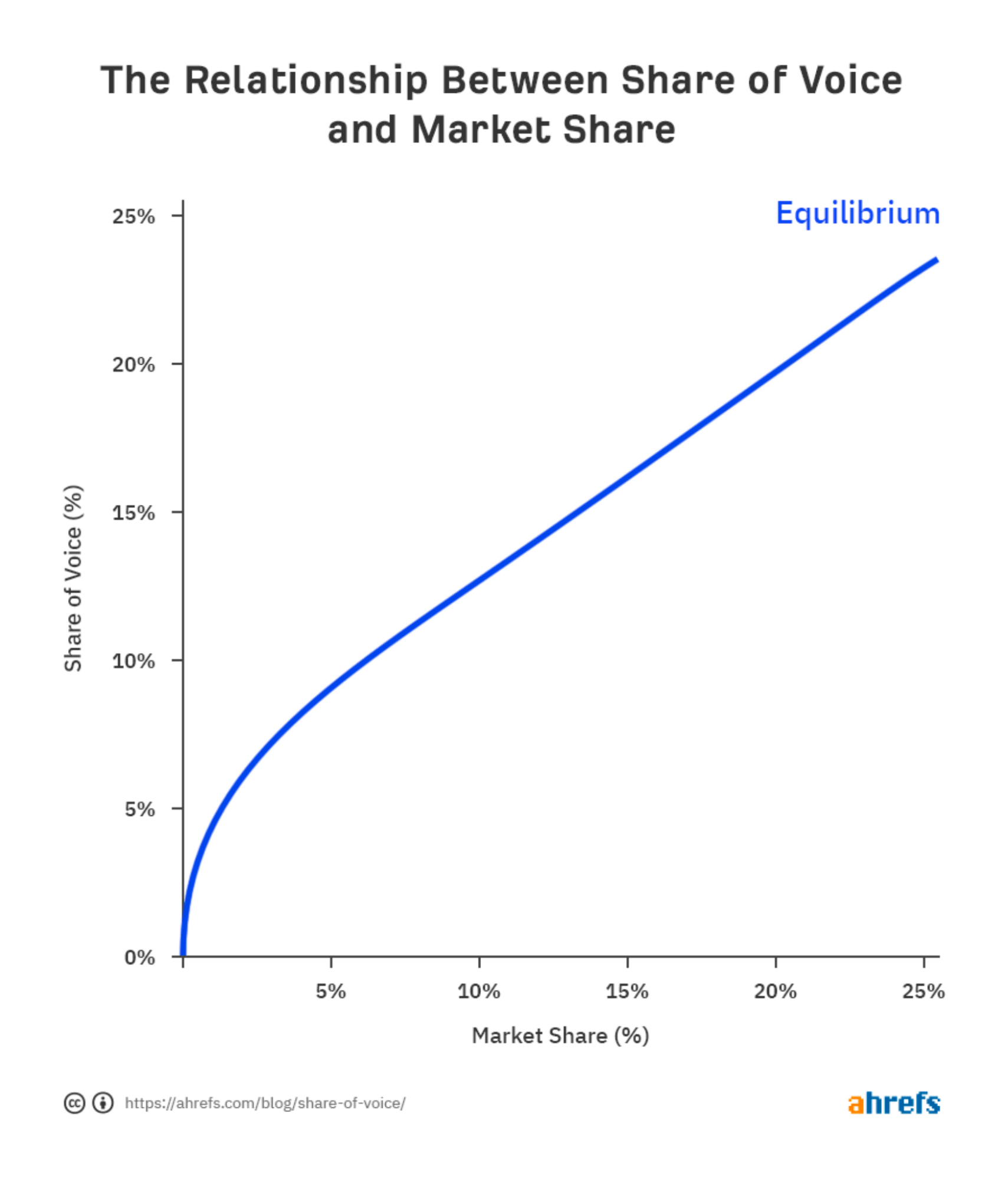
At Ahrefs, we calculate organic SOV by dividing the traffic to the site by the total search traffic for all keywords.
In other words, if you only track one keyword and the top 10 positions are occupied by pages of your website, your SOV is 100%.
So how can you measure organic SOV?
We first need to create a new project in Ahrefs’ Rank Tracker and add our keywords for the website we want to track.
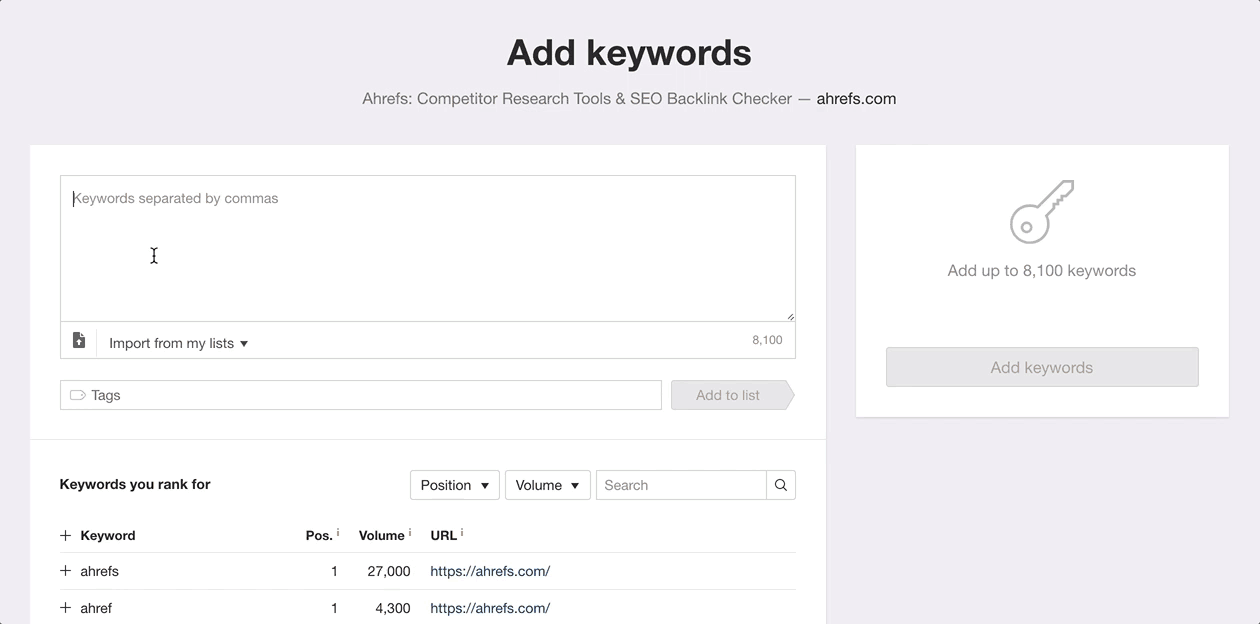
Once you have added a new project and added your keywords, you can go to the dashboard and check your SOV.
It should look something like this:

If you click through the SOV on the dashboard, you can look at your competitor’s SOV compared to your SOV.

If no competitors are showing in your dashboard, you can change that by:
- Going into Settings.
- Clicking on the Competitors tab.
- Clicking on + Add competitor.
Enter your competitors manually or press the + to add them from the list below that shows the keyword intersection.

Once you are happy, click the Save button and return to the dashboard. You should now be able to compare your competitor’s SOV against your website’s SOV.
Recommendation
Intrusive marketing is annoying.
It may seem obvious. But when our lives are full of adverts, cold calls, and emails from random people trying to sell you their products all the time, it’s very advantageous to be an inbound marketing channel.
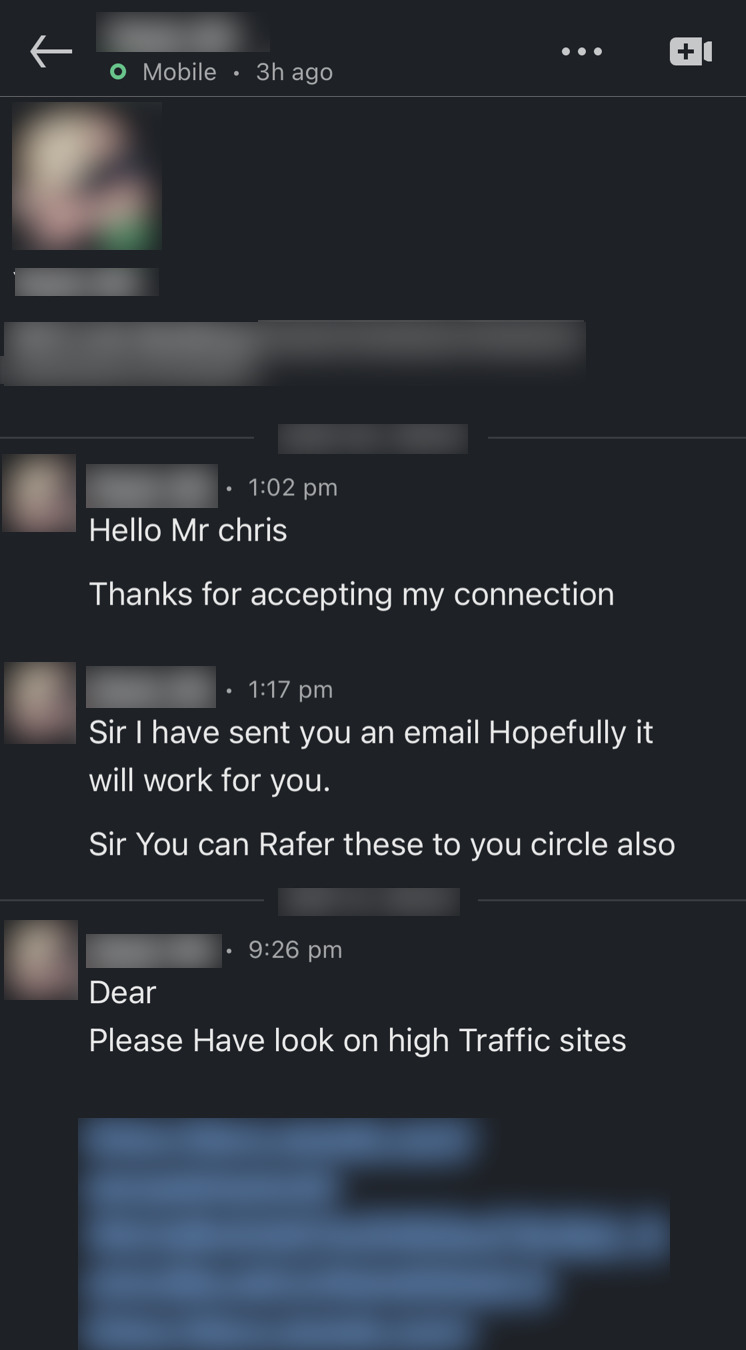
SEO targets people who are actively searching for your services or products.
Because of this, it’s excellent at converting—all you need to do is focus on what they are searching for.
You can find what your customers are searching for using Ahrefs’ Keywords Explorer.
Enter a relevant topic and go to the Matching terms report. Here, you’ll see many topics your customers are searching for, which you can target.
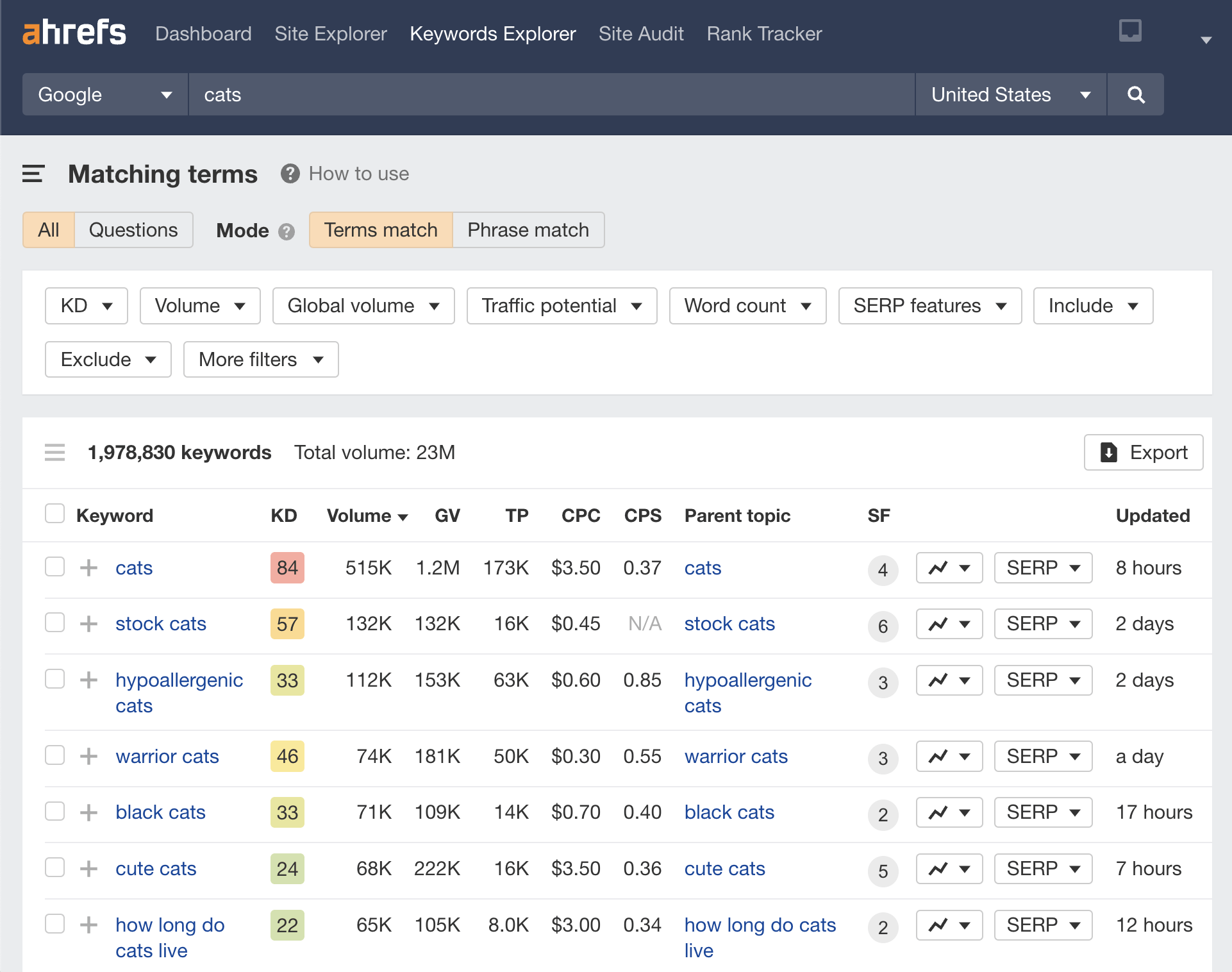
You can search, discover, and analyze keywords using our very own Ahrefs’ Keywords Explorer.
SEO is not just for Christmas.
In all, 45.6% of SEOs say SEO takes about three to six months. It may seem like a long time for the channel to work, but SEO is a long-term marketing channel where growth typically compounds over time. In other words, if you put the time and effort into SEO, the results will likely be well worth it.
Looking at Ahrefs’ organic traffic graph, most of our rapid growth occurred in the last year or so when our traffic started to compound.

Google’s algorithm updates mean that your website’s traffic will fluctuate. But as you can see from the graph, it’s a positive trend in the long term.
Over time, you should be able to rely on SEO to bring in a constant stream of traffic to your site.
When we asked ~4,300 SEOs how long SEO takes, they gave a variety of responses. But only 16.2% of SEOs said that SEO takes between one and three months.
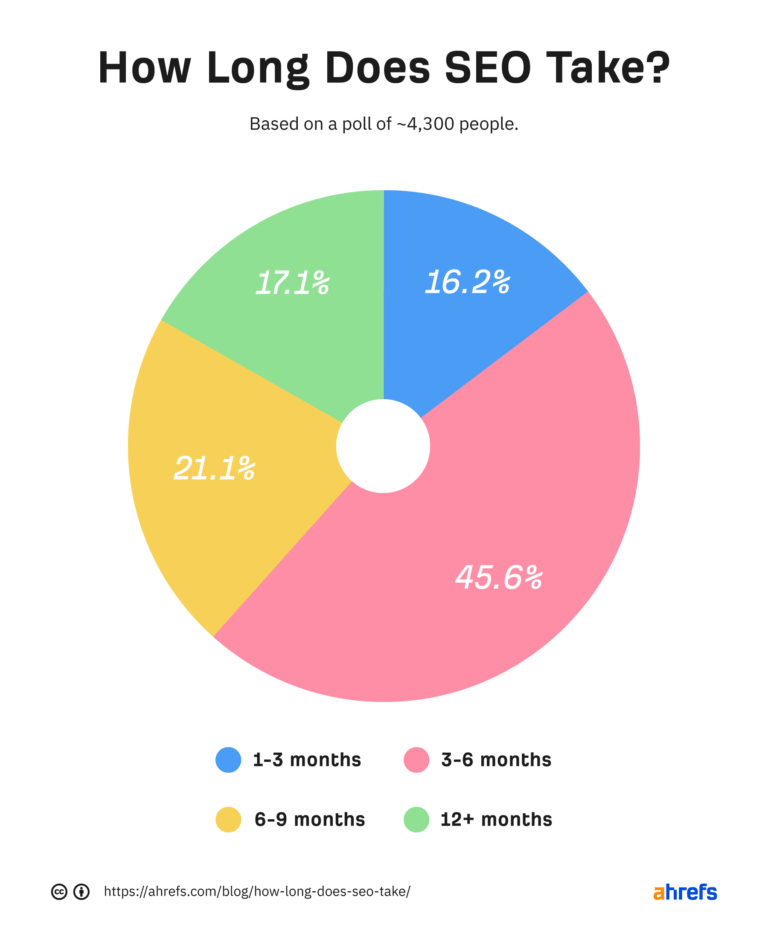
I agree with the majority of SEOs here. But I would add a qualifier—that it depends on the type of website you are working on.
For example, if you set up a brand-new website, it will have little to no authority. This is because it will have no links pointing to it and will probably have minimal content on the site.
These elements are just some indicators or ways in which Google judges your website’s authority and decides which top results should be on its SERPs.
Recommendation
If you are improving the SEO of a website that’s been around for a few years, then the SEO will likely take effect faster. This is based on my experience, but you may get different results with your website.
Unlike paying for PPC, organic search traffic is free.
If Ahrefs used PPC to pay for its organic traffic, Ahrefs’ Site Explorer estimates it would cost an eye-watering $2.3 million per month or $27.6 million per year.
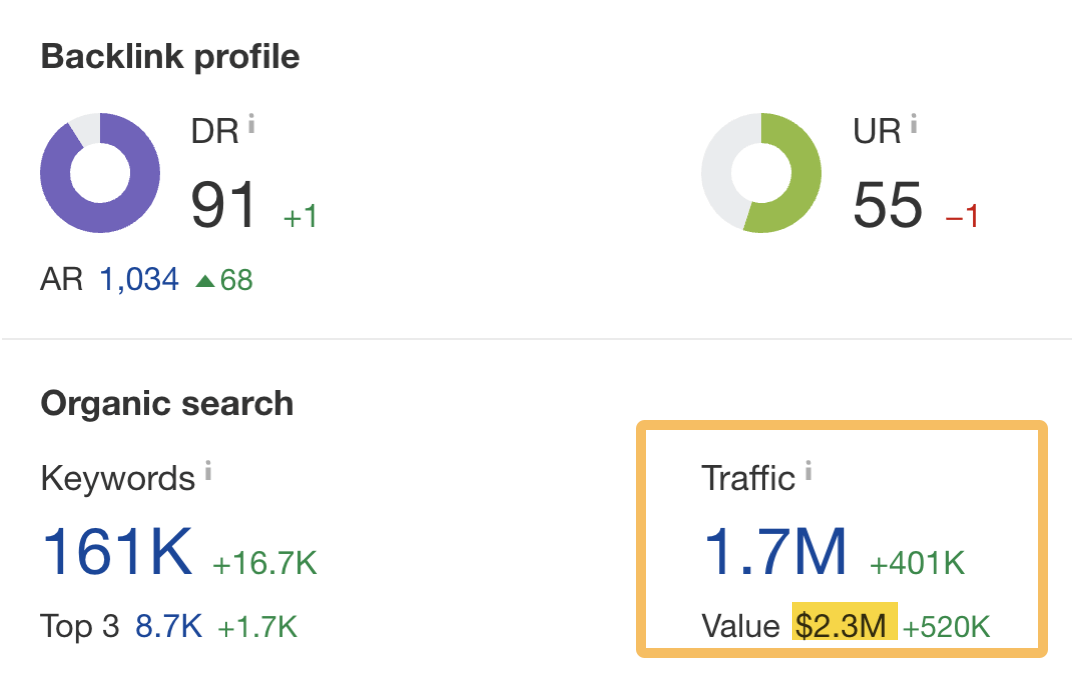
You can see from this example why improving SEO and increasing your organic traffic can be a highly valuable investment for your business.
Getting started with SEO doesn’t always mean you have to spend a lot, either. If you are willing to learn about SEO basics, you can do a lot of the work yourself to bring costs down.
Recommendation
It’s always on—24/7
Unlike paid marketing, SEO is always on. It continues to work for you while you are asleep.
You’ll get more overall value from SEO than other marketing channels. It doesn’t cost any extra to have it running all the time.
Another benefit is that once your website is established with good rankings, SEO will maintain them over time and drive consistent traffic to your website.
The only thing that can stop this is if there is a serious technical issue with your site or you have fallen foul of Google’s search guidelines.
Reduce your dependency on PPC
It’s easy for a business to rely on pay-per-click (PPC) marketing, but it can be expensive to maintain this marketing strategy.
SEO can help you change this.
Once you have some important keywords ranking number #1 on Google, you can consider turning off some of your PPC marketing, which could result in significant savings for your business.
Many people have high expectations for websites these days. They expect them to be clear, intuitive, and lightning-fast.
When websites don’t work as people expect, they get frustrated. And if they have a bad experience, this can create a negative perception of the brand.
To do well in SEO, you’ll need to provide your visitors with the best possible user experience.
But how can you optimize for user experience in SEO?
SEOs typically divide user experience issues into three categories:
- Site speed
- Core Web Vitals
- On-site optimization
Let’s take a closer look.
Site speed
Site speed is one of the most critical factors for your visitors. If your website is slow to use, visitors will likely leave your site and probably not return.
A few years ago, Google tested 900,000 websites worldwide. It reported that 53% of people would leave a website if it took three seconds or more to load.
To test your site speed, you can use a tool like webpagespeedtest.org. Let’s take a look at Ahrefs speed metrics using this tool.

We can see above that the speed index is under three seconds for Ahrefs. If your website loads in more than three seconds, then you may want to consider speeding up your website.
Core Web Vitals
Core Web Vitals are Google’s quality signals it introduced to quantify the user experience of your website.
They are:
- Largest Contentful Paint (LCP) – For load performance.
- First Input Delay (FID) – For visual stability.
- Cumulative Layout Shift (CLS) – For interactivity.
Here’s what Google classifies as good and bad scores for these metrics.
| Good | Needs improvement | Poor | |
|---|---|---|---|
| LCP | <=2.5s | <=4s | >4s |
| FID | <=100ms | <=300ms | >300ms |
| CLS | <=0.1 | <=0.25 | >0.25 |
Defining metrics for user experience is a benefit, as website owners can know exactly how their websites perform against Google’s expectations.
Monitoring Core Web Vitals and site performance may sound technical, but you can keep an eye on them using Ahrefs’ Site Audit.
For example, here’s a screenshot from the Performance dashboard highlighting two issues with CLS and LCP.

As you can see from the above, Site Audit automatically identifies all low-performing pages for you.
On-page optimization
On-page optimization is another area of SEO that can help benefit your website. With on-page optimization, SEOs critically examine your website and audit it for any issues that may impact the user experience.
A good example of on-page optimization is adding subheadings, or heading tags, to your articles. Adding subheadings makes your content easier to read by establishing a visual hierarchy.
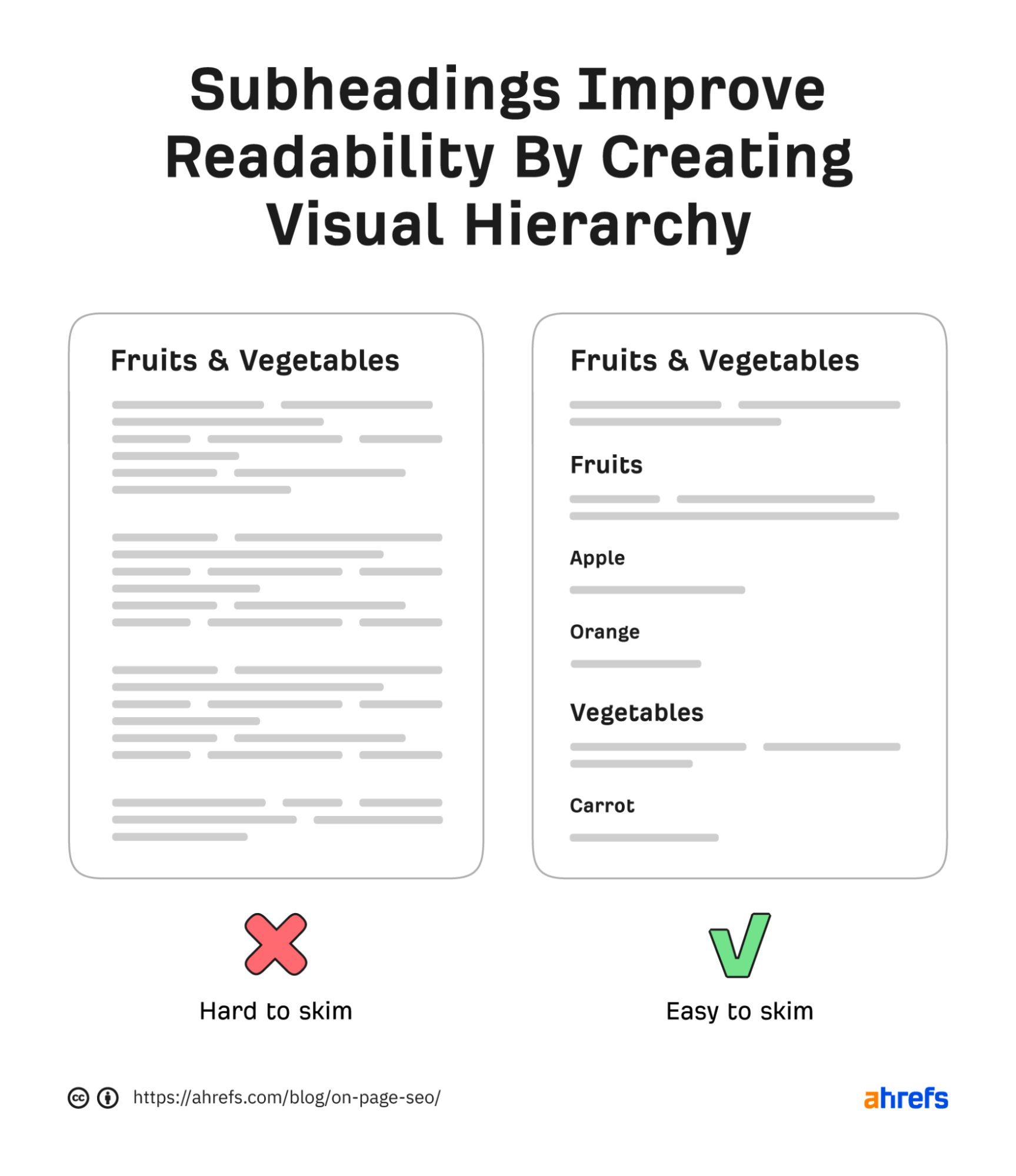
On-page optimization is less quantifiable than Core Web Vitals, but spending time on it will pay dividends for your website in the long run.
Ahrefs’ Site Audit can monitor headings, image alt text, internal linking, and other on-page optimization factors.
Here’s an example of a scheduled report you can get for heading optimization opportunities.

You can use this report to identify many improvement opportunities for your website.
If your business has a physical store, you can add it to a Google Business Profile for free.

Adding your business to Google’s business listings means you will appear on Google Maps when someone searches for your business or related keywords.
It’s a great way to highlight your business locally. For some businesses focused on local trade, this listing can be one of their most crucial organic search assets.
It also gives you a helpful way to communicate your business hours and opening times to your customers—something they will appreciate.
By having a solid organic presence and utilizing tools such as Google Business Profile, you can be sure that your online business will pick up sales even when you can’t open your physical store.
So how do you set up your own Google Business Profile listing?
Setting up a Google Business Profile is straightforward and a three-step process.
- Claim your business profile
- Add your business hours and details
- Manage your profile, share any business updates, and respond to customer reviews
Once you have done this, you can monitor your business profile’s performance with the built-in analytics.

Using a Google Business Profile allows you to discover how people are searching for your website and helps you to understand how your business connects with customers online.
Building trust with customers is just as important online as it is offline. You wouldn’t buy something from a physical shop if the shop was run-down and the service was poor.
The same applies to websites.
Your website should be fully operational and perform well in search engines. It should be secure and provide a great user experience to your customers.
Having good SEO on your website shows you’re an authority in your industry. It shows you have the information and expertise customers are looking for.
It also means searchers will click on your website in the results because it is more prominent than your competitors—you will get the customers, and they won’t.
The bottom line here is that by improving your website’s SEO, more visitors will trust your brand, which will drive more traffic and sales.
Learn more
Now you know the key benefits of SEO, you may want to start learning about it in more detail.
I’ve collected some helpful resources below to help you get started, so you can learn about SEO and start to reap the benefits:
Got more questions? Ping me on Twitter. 🙂
SEO
Measuring Content Impact Across The Customer Journey

Understanding the impact of your content at every touchpoint of the customer journey is essential – but that’s easier said than done. From attracting potential leads to nurturing them into loyal customers, there are many touchpoints to look into.
So how do you identify and take advantage of these opportunities for growth?
Watch this on-demand webinar and learn a comprehensive approach for measuring the value of your content initiatives, so you can optimize resource allocation for maximum impact.
You’ll learn:
- Fresh methods for measuring your content’s impact.
- Fascinating insights using first-touch attribution, and how it differs from the usual last-touch perspective.
- Ways to persuade decision-makers to invest in more content by showcasing its value convincingly.
With Bill Franklin and Oliver Tani of DAC Group, we unravel the nuances of attribution modeling, emphasizing the significance of layering first-touch and last-touch attribution within your measurement strategy.
Check out these insights to help you craft compelling content tailored to each stage, using an approach rooted in first-hand experience to ensure your content resonates.
Whether you’re a seasoned marketer or new to content measurement, this webinar promises valuable insights and actionable tactics to elevate your SEO game and optimize your content initiatives for success.
View the slides below or check out the full webinar for all the details.
SEO
How to Find and Use Competitor Keywords

Competitor keywords are the keywords your rivals rank for in Google’s search results. They may rank organically or pay for Google Ads to rank in the paid results.
Knowing your competitors’ keywords is the easiest form of keyword research. If your competitors rank for or target particular keywords, it might be worth it for you to target them, too.
There is no way to see your competitors’ keywords without a tool like Ahrefs, which has a database of keywords and the sites that rank for them. As far as we know, Ahrefs has the biggest database of these keywords.
How to find all the keywords your competitor ranks for
- Go to Ahrefs’ Site Explorer
- Enter your competitor’s domain
- Go to the Organic keywords report
The report is sorted by traffic to show you the keywords sending your competitor the most visits. For example, Mailchimp gets most of its organic traffic from the keyword “mailchimp.”


Since you’re unlikely to rank for your competitor’s brand, you might want to exclude branded keywords from the report. You can do this by adding a Keyword > Doesn’t contain filter. In this example, we’ll filter out keywords containing “mailchimp” or any potential misspellings:


If you’re a new brand competing with one that’s established, you might also want to look for popular low-difficulty keywords. You can do this by setting the Volume filter to a minimum of 500 and the KD filter to a maximum of 10.


How to find keywords your competitor ranks for, but you don’t
- Go to Competitive Analysis
- Enter your domain in the This target doesn’t rank for section
- Enter your competitor’s domain in the But these competitors do section


Hit “Show keyword opportunities,” and you’ll see all the keywords your competitor ranks for, but you don’t.


You can also add a Volume and KD filter to find popular, low-difficulty keywords in this report.


How to find keywords multiple competitors rank for, but you don’t
- Go to Competitive Analysis
- Enter your domain in the This target doesn’t rank for section
- Enter the domains of multiple competitors in the But these competitors do section


You’ll see all the keywords that at least one of these competitors ranks for, but you don’t.


You can also narrow the list down to keywords that all competitors rank for. Click on the Competitors’ positions filter and choose All 3 competitors:


- Go to Ahrefs’ Site Explorer
- Enter your competitor’s domain
- Go to the Paid keywords report


This report shows you the keywords your competitors are targeting via Google Ads.
Since your competitor is paying for traffic from these keywords, it may indicate that they’re profitable for them—and could be for you, too.
You know what keywords your competitors are ranking for or bidding on. But what do you do with them? There are basically three options.
1. Create pages to target these keywords
You can only rank for keywords if you have content about them. So, the most straightforward thing you can do for competitors’ keywords you want to rank for is to create pages to target them.
However, before you do this, it’s worth clustering your competitor’s keywords by Parent Topic. This will group keywords that mean the same or similar things so you can target them all with one page.
Here’s how to do that:
- Export your competitor’s keywords, either from the Organic Keywords or Content Gap report
- Paste them into Keywords Explorer
- Click the “Clusters by Parent Topic” tab


For example, MailChimp ranks for keywords like “what is digital marketing” and “digital marketing definition.” These and many others get clustered under the Parent Topic of “digital marketing” because people searching for them are all looking for the same thing: a definition of digital marketing. You only need to create one page to potentially rank for all these keywords.


2. Optimize existing content by filling subtopics
You don’t always need to create new content to rank for competitors’ keywords. Sometimes, you can optimize the content you already have to rank for them.
How do you know which keywords you can do this for? Try this:
- Export your competitor’s keywords
- Paste them into Keywords Explorer
- Click the “Clusters by Parent Topic” tab
- Look for Parent Topics you already have content about
For example, if we analyze our competitor, we can see that seven keywords they rank for fall under the Parent Topic of “press release template.”


If we search our site, we see that we already have a page about this topic.


If we click the caret and check the keywords in the cluster, we see keywords like “press release example” and “press release format.”


To rank for the keywords in the cluster, we can probably optimize the page we already have by adding sections about the subtopics of “press release examples” and “press release format.”
3. Target these keywords with Google Ads
Paid keywords are the simplest—look through the report and see if there are any relevant keywords you might want to target, too.
For example, Mailchimp is bidding for the keyword “how to create a newsletter.”


If you’re ConvertKit, you may also want to target this keyword since it’s relevant.
If you decide to target the same keyword via Google Ads, you can hover over the magnifying glass to see the ads your competitor is using.


You can also see the landing page your competitor directs ad traffic to under the URL column.


Learn more
Check out more tutorials on how to do competitor keyword analysis:
SEO
Google Confirms Links Are Not That Important

Google’s Gary Illyes confirmed at a recent search marketing conference that Google needs very few links, adding to the growing body of evidence that publishers need to focus on other factors. Gary tweeted confirmation that he indeed say those words.
Background Of Links For Ranking
Links were discovered in the late 1990’s to be a good signal for search engines to use for validating how authoritative a website is and then Google discovered soon after that anchor text could be used to provide semantic signals about what a webpage was about.
One of the most important research papers was Authoritative Sources in a Hyperlinked Environment by Jon M. Kleinberg, published around 1998 (link to research paper at the end of the article). The main discovery of this research paper is that there is too many web pages and there was no objective way to filter search results for quality in order to rank web pages for a subjective idea of relevance.
The author of the research paper discovered that links could be used as an objective filter for authoritativeness.
Kleinberg wrote:
“To provide effective search methods under these conditions, one needs a way to filter, from among a huge collection of relevant pages, a small set of the most “authoritative” or ‘definitive’ ones.”
This is the most influential research paper on links because it kick-started more research on ways to use links beyond as an authority metric but as a subjective metric for relevance.
Objective is something factual. Subjective is something that’s closer to an opinion. The founders of Google discovered how to use the subjective opinions of the Internet as a relevance metric for what to rank in the search results.
What Larry Page and Sergey Brin discovered and shared in their research paper (The Anatomy of a Large-Scale Hypertextual Web Search Engine – link at end of this article) was that it was possible to harness the power of anchor text to determine the subjective opinion of relevance from actual humans. It was essentially crowdsourcing the opinions of millions of website expressed through the link structure between each webpage.
What Did Gary Illyes Say About Links In 2024?
At a recent search conference in Bulgaria, Google’s Gary Illyes made a comment about how Google doesn’t really need that many links and how Google has made links less important.
Patrick Stox tweeted about what he heard at the search conference:
” ‘We need very few links to rank pages… Over the years we’ve made links less important.’ @methode #serpconf2024″
Google’s Gary Illyes tweeted a confirmation of that statement:
“I shouldn’t have said that… I definitely shouldn’t have said that”
Why Links Matter Less
The initial state of anchor text when Google first used links for ranking purposes was absolutely non-spammy, which is why it was so useful. Hyperlinks were primarily used as a way to send traffic from one website to another website.
But by 2004 or 2005 Google was using statistical analysis to detect manipulated links, then around 2004 “powered-by” links in website footers stopped passing anchor text value, and by 2006 links close to the words “advertising” stopped passing link value, links from directories stopped passing ranking value and by 2012 Google deployed a massive link algorithm called Penguin that destroyed the rankings of likely millions of websites, many of which were using guest posting.
The link signal eventually became so bad that Google decided in 2019 to selectively use nofollow links for ranking purposes. Google’s Gary Illyes confirmed that the change to nofollow was made because of the link signal.
Google Explicitly Confirms That Links Matter Less
In 2023 Google’s Gary Illyes shared at a PubCon Austin that links were not even in the top 3 of ranking factors. Then in March 2024, coinciding with the March 2024 Core Algorithm Update, Google updated their spam policies documentation to downplay the importance of links for ranking purposes.
The documentation previously said:
“Google uses links as an important factor in determining the relevancy of web pages.”
The update to the documentation that mentioned links was updated to remove the word important.
Links are not just listed as just another factor:
“Google uses links as a factor in determining the relevancy of web pages.”
At the beginning of April Google’s John Mueller advised that there are more useful SEO activities to engage on than links.
Mueller explained:
“There are more important things for websites nowadays, and over-focusing on links will often result in you wasting your time doing things that don’t make your website better overall”
Finally, Gary Illyes explicitly said that Google needs very few links to rank webpages and confirmed it.
I shouldn’t have said that… I definitely shouldn’t have said that
— Gary 鯨理/경리 Illyes (so official, trust me) (@methode) April 19, 2024
Why Google Doesn’t Need Links
The reason why Google doesn’t need many links is likely because of the extent of AI and natural language undertanding that Google uses in their algorithms. Google must be highly confident in its algorithm to be able to explicitly say that they don’t need it.
Way back when Google implemented the nofollow into the algorithm there were many link builders who sold comment spam links who continued to lie that comment spam still worked. As someone who started link building at the very beginning of modern SEO (I was the moderator of the link building forum at the #1 SEO forum of that time), I can say with confidence that links have stopped playing much of a role in rankings beginning several years ago, which is why I stopped about five or six years ago.
Read the research papers
Authoritative Sources in a Hyperlinked Environment – Jon M. Kleinberg (PDF)
The Anatomy of a Large-Scale Hypertextual Web Search Engine
Featured Image by Shutterstock/RYO Alexandre
-

 PPC4 days ago
PPC4 days ago19 Best SEO Tools in 2024 (For Every Use Case)
-

 MARKETING7 days ago
MARKETING7 days agoWill Google Buy HubSpot? | Content Marketing Institute
-
SEARCHENGINES7 days ago
Daily Search Forum Recap: April 16, 2024
-

 SEO6 days ago
SEO6 days agoGoogle Clarifies Vacation Rental Structured Data
-

 MARKETING6 days ago
MARKETING6 days agoStreamlining Processes for Increased Efficiency and Results
-
SEARCHENGINES5 days ago
Daily Search Forum Recap: April 17, 2024
-

 PPC7 days ago
PPC7 days agoHow to Collect & Use Customer Data the Right (& Ethical) Way
-

 SEO6 days ago
SEO6 days agoAn In-Depth Guide And Best Practices For Mobile SEO
















You must be logged in to post a comment Login